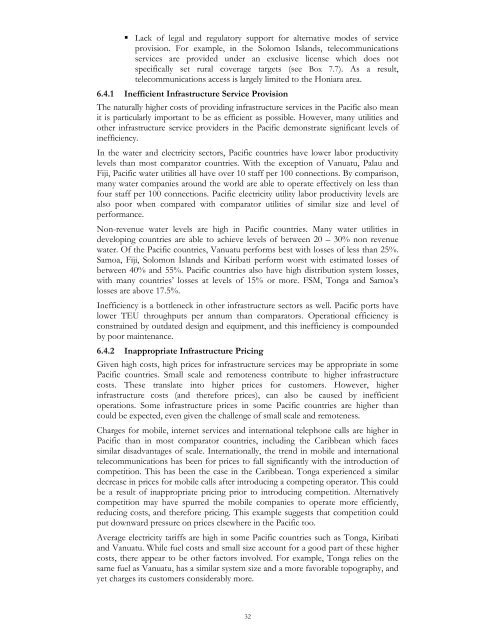EAP - The Pacific Infrastructure Challenge - World Bank (2006).pdf
EAP - The Pacific Infrastructure Challenge - World Bank (2006).pdf
EAP - The Pacific Infrastructure Challenge - World Bank (2006).pdf
Create successful ePaper yourself
Turn your PDF publications into a flip-book with our unique Google optimized e-Paper software.
Lack of legal and regulatory support for alternative modes of service<br />
provision. For example, in the Solomon Islands, telecommunications<br />
services are provided under an exclusive license which does not<br />
specifically set rural coverage targets (see Box 7.7). As a result,<br />
telecommunications access is largely limited to the Honiara area.<br />
6.4.1 Inefficient <strong>Infrastructure</strong> Service Provision<br />
<strong>The</strong> naturally higher costs of providing infrastructure services in the <strong>Pacific</strong> also mean<br />
it is particularly important to be as efficient as possible. However, many utilities and<br />
other infrastructure service providers in the <strong>Pacific</strong> demonstrate significant levels of<br />
inefficiency.<br />
In the water and electricity sectors, <strong>Pacific</strong> countries have lower labor productivity<br />
levels than most comparator countries. With the exception of Vanuatu, Palau and<br />
Fiji, <strong>Pacific</strong> water utilities all have over 10 staff per 100 connections. By comparison,<br />
many water companies around the world are able to operate effectively on less than<br />
four staff per 100 connections. <strong>Pacific</strong> electricity utility labor productivity levels are<br />
also poor when compared with comparator utilities of similar size and level of<br />
performance.<br />
Non-revenue water levels are high in <strong>Pacific</strong> countries. Many water utilities in<br />
developing countries are able to achieve levels of between 20 – 30% non revenue<br />
water. Of the <strong>Pacific</strong> countries, Vanuatu performs best with losses of less than 25%.<br />
Samoa, Fiji, Solomon Islands and Kiribati perform worst with estimated losses of<br />
between 40% and 55%. <strong>Pacific</strong> countries also have high distribution system losses,<br />
with many countries’ losses at levels of 15% or more. FSM, Tonga and Samoa’s<br />
losses are above 17.5%.<br />
Inefficiency is a bottleneck in other infrastructure sectors as well. <strong>Pacific</strong> ports have<br />
lower TEU throughputs per annum than comparators. Operational efficiency is<br />
constrained by outdated design and equipment, and this inefficiency is compounded<br />
by poor maintenance.<br />
6.4.2 Inappropriate <strong>Infrastructure</strong> Pricing<br />
Given high costs, high prices for infrastructure services may be appropriate in some<br />
<strong>Pacific</strong> countries. Small scale and remoteness contribute to higher infrastructure<br />
costs. <strong>The</strong>se translate into higher prices for customers. However, higher<br />
infrastructure costs (and therefore prices), can also be caused by inefficient<br />
operations. Some infrastructure prices in some <strong>Pacific</strong> countries are higher than<br />
could be expected, even given the challenge of small scale and remoteness.<br />
Charges for mobile, internet services and international telephone calls are higher in<br />
<strong>Pacific</strong> than in most comparator countries, including the Caribbean which faces<br />
similar disadvantages of scale. Internationally, the trend in mobile and international<br />
telecommunications has been for prices to fall significantly with the introduction of<br />
competition. This has been the case in the Caribbean. Tonga experienced a similar<br />
decrease in prices for mobile calls after introducing a competing operator. This could<br />
be a result of inappropriate pricing prior to introducing competition. Alternatively<br />
competition may have spurred the mobile companies to operate more efficiently,<br />
reducing costs, and therefore pricing. This example suggests that competition could<br />
put downward pressure on prices elsewhere in the <strong>Pacific</strong> too.<br />
Average electricity tariffs are high in some <strong>Pacific</strong> countries such as Tonga, Kiribati<br />
and Vanuatu. While fuel costs and small size account for a good part of these higher<br />
costs, there appear to be other factors involved. For example, Tonga relies on the<br />
same fuel as Vanuatu, has a similar system size and a more favorable topography, and<br />
yet charges its customers considerably more.<br />
32

















